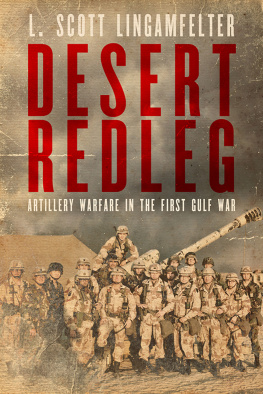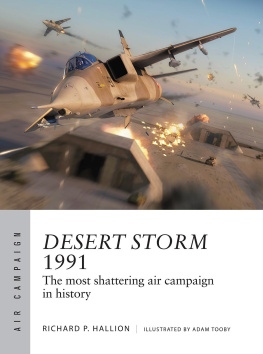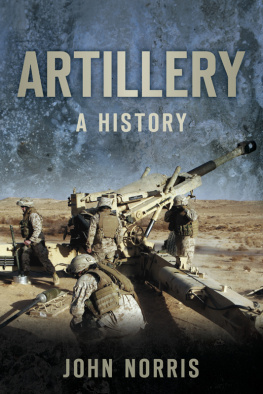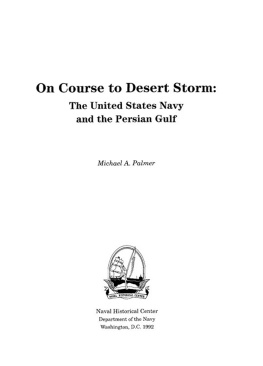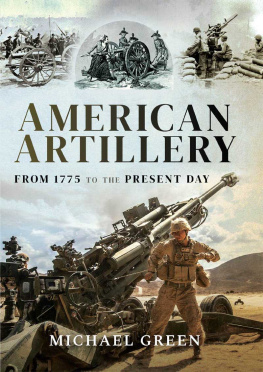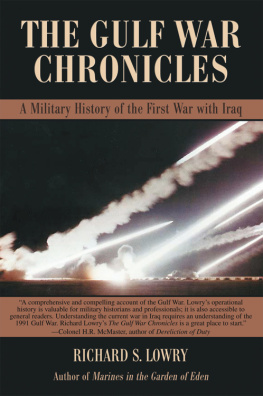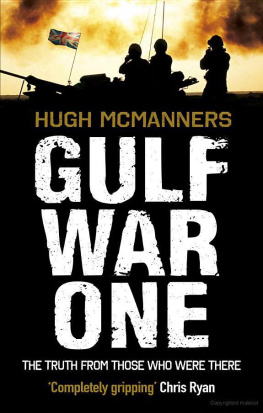
DESERT
REDLEG
AMERICAN WARRIORS
Throughout the nations history, numerous men and women of all ranks and branches of the US military have served their country with honor and distinction. During times of war and peace, there are individuals whose exemplary achievements embody the highest standards of the US armed forces. The aim of the American Warriors series is to examine the unique historical contributions of these individuals, whose legacies serve as enduring examples for soldiers and citizens alike. The series will promote a deeper and more comprehensive understanding of the US armed forces.
SERIES EDITOR: Joseph Craig

An AUSA Book
DESERT
REDLEG
ARTILLERY WARFARE IN
THE FIRST GULF WAR
L. SCOTT LINGAMFELTER
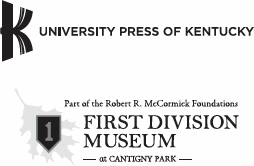
The First Division Museum at Cantigny Park in Wheaton, Illinois, is proud to partner with the Association of the US Army and the University Press of Kentucky in the publication of this important account of the Persian Gulf War. We believe that familiarity with our military past fosters responsible citizenship and the military and civic leadership that will help ensure our democracy for the future. The museum is part of the Robert R. McCormick Foundation, Chicago, Illinois.
www.fdmuseum.org
This book is dedicated to all the soldiers who gave or were willing to give the last full measure of devotion to the United States of America while serving in our armed forces. It is also dedicated to their families and mine, especially to my children and grandchildren, so they will know.
Copyright 2020 by The University Press of Kentucky
Scholarly publisher for the Commonwealth,
serving Bellarmine University, Berea College, Centre
College of Kentucky, Eastern Kentucky University,
The Filson Historical Society, Georgetown College,
Kentucky Historical Society, Kentucky State University,
Morehead State University, Murray State University,
Northern Kentucky University, Transylvania University,
University of Kentucky, University of Louisville,
and Western Kentucky University.
All rights reserved.
Editorial and Sales Offices: The University Press of Kentucky
663 South Limestone Street, Lexington, Kentucky 405084008
www.kentuckypress.com
Cataloging-in-Publication data available from the Library of Congress
ISBN 978-0-8131-7920-9 (hardcover)
ISBN 978-0-8131-7922-3 (pdf)
ISBN 978-0-8131-7923-0 (epub)
This book is printed on acid-free paper meeting
the requirements of the American National Standard
for Permanence in Paper for Printed Library Materials.

Manufactured in the United States of America.

| Member of the Association
of University Presses |
Contents
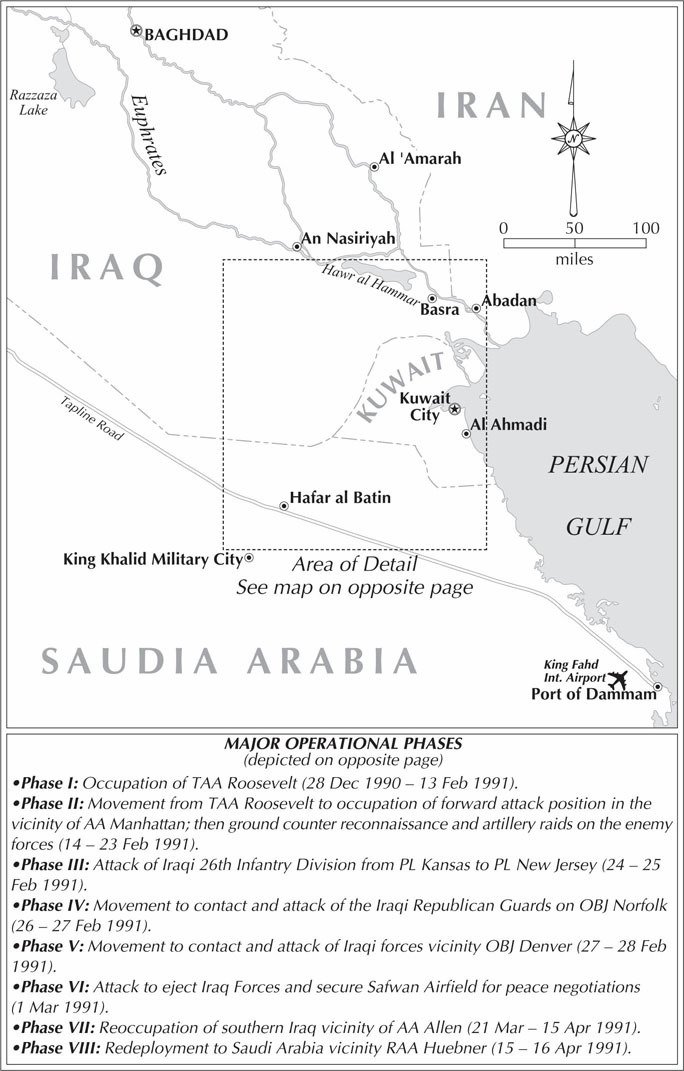
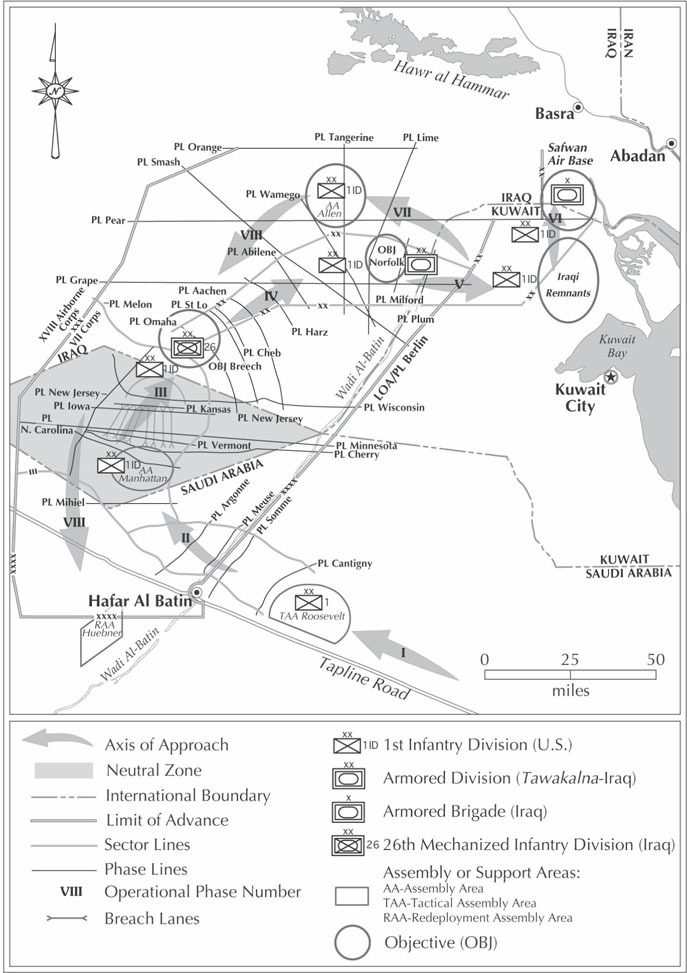
Movements of the 1st Infantry Division from January to April 1991
Introduction
This book is not designed to be a history. Thats left to others. It is one mans view of a war he never thought he would fight. My view. An artillerymans view.
When I entered the US Army in 1973 as a freshly minted second lieutenant from the Virginia Military Institute in Lexington, Virginia, America was in the waning years of the Vietnam conflict. When the selective service draft that recruited soldiers for the war ended on January 27, 1973, America committed to a volunteer Army, even as the Cold War still loomed before us. I was a member of that Army, deployed to the Federal Republic of Germany (FRG) standing opposite the armed forces of the Russian-led Warsaw Pact. Then, as now, the politico-military rivalry between the US and the former Soviet Union (USSR) was fraught with danger. One simple miscalculation by either superpower might result in World War III, a sobering reality for a young second lieutenant newly assigned to a heavy artillery, nuclear-capable battalion in the US V Corps Artillery.
Despite conflicts between the Arabs and Israelis in the Middle East at the time, which had flared badly during the 1973 Arab-Israeli War, the idea of fighting a future war in the deserts of Kuwait and Iraq was far from the minds of the soldiers and officers of my unit, the 2nd Battalion, 92nd Field Artillery. Garrisoned in the Hessian town of Giessen, north of Frankfurt, we riveted our attention on the Fulda Gap, the historic highspeed avenue of approach in upper Hesse that ran northeast to southwest of our position, offering two enticing avenues of advance to the Soviets. These two lowland corridors combined to form the gap, as we called it, which was a certain pathway for the tank-heavy forces of the USSR. If they chose to, they could launch a massive assault on North Atlantic Treaty Organization (NATO) forces stationed in the FRG. It was a real threat, one that gripped our attention. We had the clear mission to block any Soviet incursion into Central Europe, and frankly, for those of us in the Red Devil battalion equipped with powerful and accurate 203mm (8-inch) self-propelled howitzers, the Middle East was someone elses problem. We had enough to worry about in Central Europe.
Indeed, the Army had just emerged from war-torn Vietnam and was demoralized and struggling to recover. That effort was made no easier by major budget cuts and downsizing measures to the entire force during the administration of President Jimmy Carter (19771981). What resulted was what we termed the hollow Army. Despite the weakened state of Americas Army then, we quickly pivoted from our preoccupation with Vietnam to focus more keenly on the Soviet threat. Prosecuting war in the Middle East simply wasnt in the cards for those of us worried about Soviet tanks descending on the plains of Germany.
In time, things would improve for the Army. In 1981 President Ronald Reagan made a major commitment to rebuild American military strength. Ironically, while the improved weapons, newly focused war-fighting doctrine, and quality soldiers resulting from that military buildup rescued the Army from its hollowed-out condition, we would never engage the Soviets in direct combat. Rather, in 1991, that enhanced Army would encounter Moscows well-armed surrogates, the Iraqis, on the desert plains of Iraq and Kuwait and, in the process, defeat that proxy force in detail. Indeed, the improved Army of Operations Desert Shield and Desert Stormthe operational title given to what has been generally referred to as the First Gulf Warwould engage in a conflict that was unanticipated and improbable in our estimation. Any American involvement in a Middle Eastern war would surely be one of stand-off support, providing help from afar. This was how we thought we would assist our close ally Israel if Arab armies attacked it. Indeed, this is precisely how we assisted Israel in 1973. Any war in the Middle East, we reasoned, directly involving the US would certainly be one on Israels side, not fighting as we did to liberate one Arab nation from another in Desert Storm.
Next page
